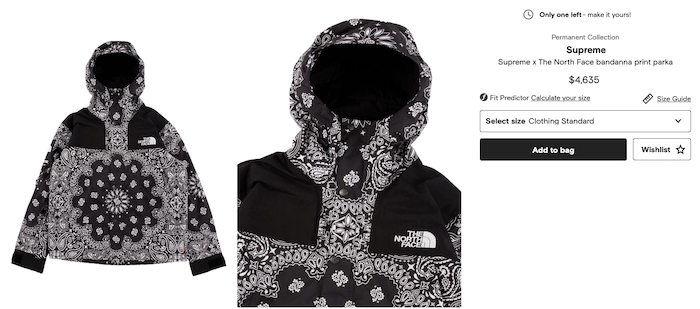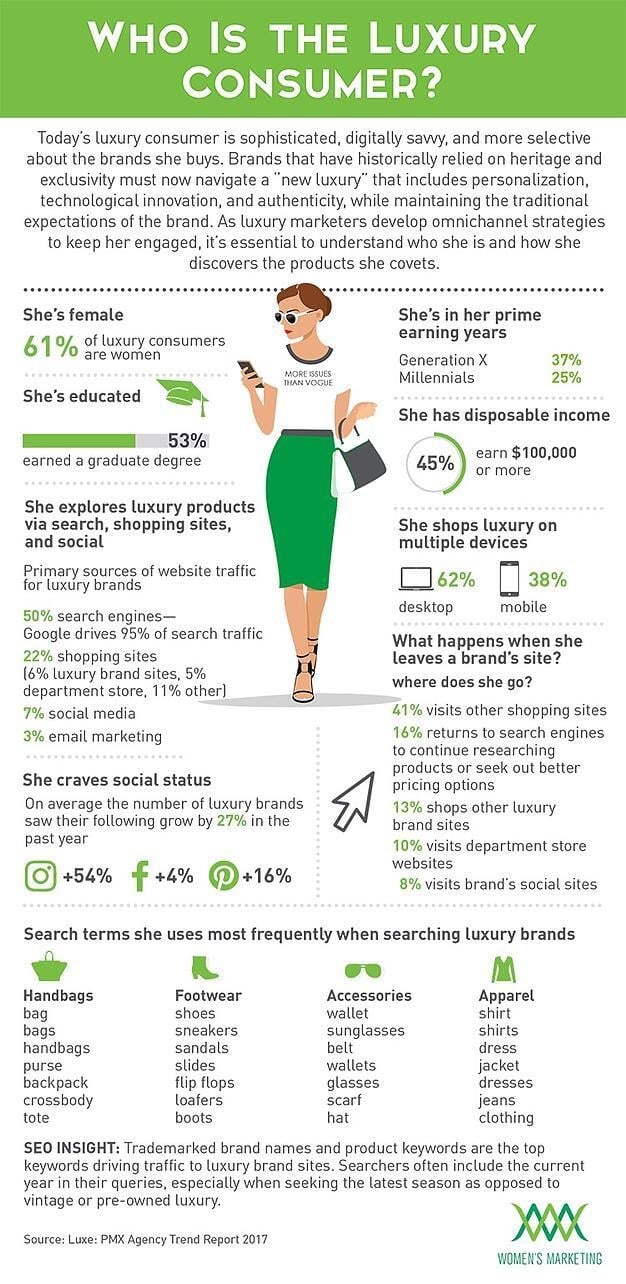
Have you ever seen a Facebook ad for Chanel? Or an Instagram ad for Lamborghini?
Me neither. That’s because luxury marketing strategies don’t follow the same rules as mass-market brands.
Selling to high-end consumers requires a different approach. But that doesn’t mean popular digital channels are off-limits.
SEO, PPC, even some social media sites can drive online sales for your luxury brand.
Today, I’m going to show you exactly how to take your luxury brand online with the best luxury marketing strategies.
What Qualifies as a Luxury Brand?
Gucci, Rolex, Ferrari. For the most part, you know luxury brands when you hear them.
But what does it take for a brand to qualify as a luxury? In my opinion, it’s down to the three Es: Expensive, Excellent, and Exclusive.
Luxury products are synonymous with high price tags. This is the most common indicator of luxury, but it is also the most misleading. Just because something costs thousands of dollars doesn’t mean it’s luxury.
That’s why luxury products also need to be excellent. The quality has to match the price tag. Good doesn’t cut it in the luxury category; a brand has to be at the very top of the market.
Luxury fashion is created by the best designers in the world. The best engineers create luxury cars. Ditto for timepieces.
Finally, luxury products have to be exclusive. It’s not a luxury product if everyone has one. Often, exclusivity is achieved by price. A ten thousand dollar handbag is well out of reach of the majority of consumers. But brands can also achieve exclusivity by selling a limited number of products. Or they can do both, like Supreme.

Luxury Marketing Trends
According to Statista, the global luxury goods market will increase from $285.1 billion in 2020 to $388 billion in 2025.
Despite what you might think, online sales of personal luxury goods are growing, too. McKinsey estimates 8% of all luxury sales are made online or around €20 billion. That’s a five-fold increase from 2009. What’s more, the majority (almost 80%) of purchases made in-store are influenced by digital.
The consultancy expects online luxury sales to triple by 2025 when almost one in five personal luxury sales will happen online.
Digital channels will be essential for luxury brands going forward. The pandemic hit department stores hard and forced luxury consumers to buy online more than before.
BCG predicts the e-commerce boom will continue in the future both for inspiration and for transactions.
Going digital will also be key to meeting today’s new luxury consumers and those of tomorrow. Millennials, who are entering their peak earning years, and Gen Z, many of whom are just entering the workforce, have grown up in the digital era and expect brands to have an online presence as high-quality as their products.
All that’s to say: digital marketing must be a key part of a luxury brand’s strategy going forward.
Luxury Brand Marketing Strategies
Here’s the thing, luxury marketing isn’t synonymous with digital marketing…yet.
Until now, luxury brands have been able to rely on full-page ads in premium magazines, billboards in duty-free stores, and high-end, high budget TV ads.
Not any more.
To survive in the increasingly competitive luxury space and attract new customers, luxury brands must understand what the luxury consumer wants from a brand and how digital can help them get there.
From SEO to PPC, apps to AR, there are loads of marketing strategies to explore.
Understand the Luxury Customer
The first step in developing a luxury marketing strategy is to understand your audience. Enter buyer personas.
A buyer persona is a detailed description of your ideal consumer. It will include their age, demographic, job, hobbies, salary, and anything else relevant. The more detail you can include, the better.
Here’s an example of a luxury consumer persona from Stella Rising.

Keep in mind; you may not have just one buyer persona. If several different groups of people buy your products, you’ll need to develop a buyer persona for each of them.
Detailed buyer personas help your brand understand precisely who your customers are and what they want from your brand.
They will allow you to better communicate with your customers and focus your marketing efforts.
Develop Your Digital Luxury Marketing Strategy
Now you understand who your customers are and what they want from your brand, you can build a marketing strategy that will drive results.
Start by thinking about the channels you want to target. This could be a social media platform you want to pay particular attention to; it could be Google; it could even be a custom app.
Focus on one or two to start with, particularly if your luxury brand is new to digital marketing.
Next, define your goals. This may be increasing brand awareness, but a better and more measurable goal is an increase in sales. (It’s also easier to measure sales increase.)
Finally, work out how you’re going to measure your success. If you’re going to use SEO to increase revenue, for instance, find out how much revenue Google and Bing are responsible for right now. If you don’t already have Google Analytics tracking in place, now’s the time to set it up.
Experimental vs. Traditional Marketing
Most marketers are aware of traditional luxury marketing tactics. Full-page ads in premium magazines or weighty direct mail pieces are a luxury marketer’s bread and butter.
But those strategies won’t cut it in an increasingly digital world.
Many brands consider digital marketing experimental in itself. But I urge luxury brands to go beyond standard digital marketing tactics and explore more experimental channels.
One option is a brand app. Apps offer brands a way to speak to users directly through their smartphones. Your app could be as simple as a mobile responsive version of your website.
Or you could take things even further by integrating augmented reality features. Burberry, for instance, has launched an AR shopping tool that lets consumers see Burberry products in their surrounding environment.
Chanel has combined offline marketing with digital marketing in a holiday popup event at The Standard in New York. An AR app, which could be accessed on the Chanel website or via Snapchat, brought the popup to life.
Role of Loyalty in Luxury Marketing
Luxury brands have loyal consumers. This is important because the more loyal your customers, the less marketing you have to do.
Don’t worry; I’m not recommending creating a loyalty program. That could devalue your luxury brand.
Rather, you need to turn consumers into fiercely loyal brand advocates. One way to do that is through the quality of your products. Another way is through the quality of your marketing.
You can also partner with influencers on social media channels. Influencer marketing is incredibly cost-effective and, if done well, can put your brand in front of the right kind of consumers.
Just make sure to find influencers who already operate in the luxury space and whose audience buys the products they promote. Aspirational jet-setting influencers are a dime a dozen.
You want to work with the few who have the audience to back it up. Otherwise, you won’t see results.
Develop a Targeted Luxury Marketing Keyword Strategy
Whether you’re running an SEO campaign or a PPC campaign (or both), I recommend developing a highly targeted luxury marketing keyword strategy.
Start by targeting high-conversion keywords. Sure, attracting consumers in the research phase of their journey is important. But for the sake of your ROI, you’re going to want to target consumers who are ready to purchase.
The CPCs of luxury marketing terms can be expensive, given the competition and the price of products.
Try to advertise as the “top watch maker” on Google, and you’ll pay $80 per click. Ouch.

Or $50 to advertise as one of the best luxury compact cars.

If you want to see a return on your investment, focusing on high-intent keywords is essential.
You’ll also need to make careful use of your negative keyword list.
Unless you’re using negative keywords, you aren’t really in control over what terms your brand will appear. The last thing you want is for ads for your luxury brand to start showing up in searches containing “discount,” “sale,” or “free.”
The kind of consumer that clicks on those ads won’t match your buyer persona. Here’s how to add negative keywords to your ads.
Luxury Marketing Content Campaigns
A huge part of luxury marketing revolves around storytelling. Whether it’s the history of your brand or the craftsmanship of your products, you probably have a lot to say.
This makes content marketing campaigns a must for luxury brands.
What should you write about exactly? Well, apart from telling your brand story, I recommend using long-form content to help consumers find the right product for them.
Buying a luxury product is often a big decision, and consumers research their choices thoroughly before committing. Buying guides put your brand front and center for consideration while providing value and establishing a relationship even before the purchase has been made.
This is a strategy my team at NP Digital adopted for a prominent jewelry retailer that wanted to increase online sales.
We wrote a comprehensive piece of content about finding the perfect engagement ring that helped traffic from search engines to grow from 20% of all traffic to 30% of all traffic in the first six months of our partnership.
Your content can continue to add value for customers after purchase. Detailed guides on using and caring for luxury products make for excellent blog posts that can increase brand loyalty while attracting even more consumers.
Use the keywords you’ve discovered above to guide your content creation process. You’ll want to make sure there’s some form of content for every key term, whether that’s a category page, a blog post, or something else entirely.
SEO For Luxury Brands
Search engines are massive traffic drivers for luxury brands and play an important role in both the research and purchase phase of the consumer journey.
Yet, they are consistently undertilized by luxury brands. It doesn’t help that luxury brands tend to have poorly designed (but very good looking) websites and a lack of content for Google to crawl.
As I said above, creating new content is critical for luxury brands who want to succeed online. Targeting new, high-intent keywords is also important.
But you shouldn’t forget about the more technical aspects of SEO, like optimizing category pages. Or off-page factors, like building links.
The more time and effort you devote to understanding and implementing SEO, the more revenue your store should generate. For instance, we increase the revenue of our luxury jewelry client by 21% through SEO.
While Google should be your focus, don’t forget about Bing. Users of Microsoft’s search engine tend to be more affluent, with 25% of users having an income in the top 25%. It makes sense to focus some efforts on Bing SEO.
Conclusion
The luxury market is changing.
Luxury marketing can no longer be confined to TV channels, billboards, and glossy magazines. Now is the time to take your luxury brand digital and invest in SEO, PPC, and whatever social media your consumers use.
So here’s my question to you:
What will be the first digital channel you use to promote your luxury brand?
The post The Best Luxury Marketing Strategies appeared first on Neil Patel.
No comments:
Post a Comment